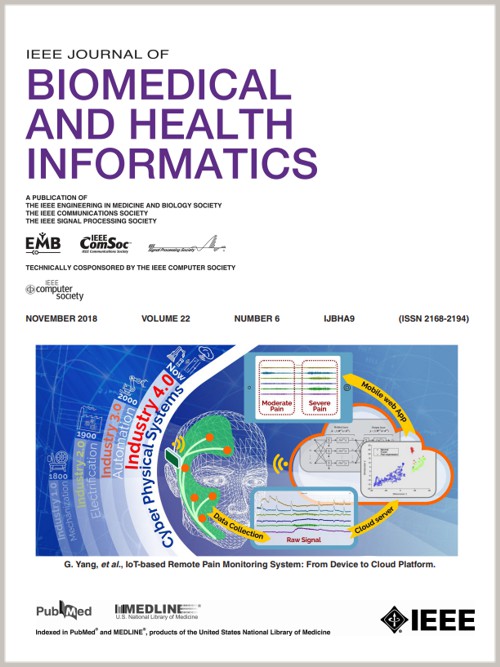Gesture Recognition Through Mechanomyogram Signals: An Adaptive Framework for Arm Posture Variability
IF 6.8
2区 医学
Q1 COMPUTER SCIENCE, INFORMATION SYSTEMS
IEEE Journal of Biomedical and Health Informatics
Pub Date : 2024-10-28
DOI:10.1109/JBHI.2024.3483428
引用次数: 0
Abstract
In hand gesture recognition, classifying gestures across multiple arm postures is challenging due to the dynamic nature of muscle fibers and the need to capture muscle activity through electrical connections with the skin. This paper presents a gesture recognition architecture addressing the arm posture challenges using an unsupervised domain adaptation technique and a wearable mechanomyogram (MMG) device that does not require electrical contact with the skin. To deal with the transient characteristics of muscle activities caused by changing arm posture, Continuous Wavelet Transform (CWT) combined with Domain-Adversarial Convolutional Neural Networks (DACNN) were used to extract MMG features and classify hand gestures. DACNN was compared with supervised trained classifiers and shown to achieve consistent improvement in classification accuracies over multiple arm postures. With less than 5 minutes of setup time to record 20 examples per gesture in each arm posture, the developed method achieved an average prediction accuracy of通过机械肌动图信号识别手势:针对手臂姿势变化的自适应框架
在手势识别中,由于肌肉纤维的动态特性,以及需要通过与皮肤的电连接来捕捉肌肉活动,因此对多种手臂姿势的手势进行分类具有挑战性。本文提出了一种手势识别架构,利用无监督领域适应技术和无需与皮肤电接触的可穿戴机械肌电图(MMG)设备来应对手臂姿势挑战。为了处理手臂姿势变化引起的肌肉活动的瞬态特征,我们采用了连续小波变换(CWT)与域对抗卷积神经网络(DACNN)相结合的方法来提取 MMG 特征并对手势进行分类。DACNN 与经过监督训练的分类器进行了比较,结果表明,DACNN 在多种手臂姿势的分类准确率上都有持续的提高。在不到 5 分钟的设置时间内记录每个手臂姿势下每个手势的 20 个示例,所开发的方法在对同一手臂姿势下的 5 个手势进行分类时,平均预测准确率达到 87.43%,在对 10 个不同手臂姿势进行分类时,平均预测准确率达到 64.29%。当进一步将 MMG 分割窗口从 200 毫秒扩大到 600 毫秒,以更长的响应时间为代价提取更多的判别信息时,姿态内和姿态间的准确率分别提高到 92.32% 和 71.75%。这些研究结果表明,所提出的方法有能力在非实验室使用过程中改善手臂姿势引起的动态变化的通用性,MMG 有潜力成为与广泛使用的肌电图(EMG)手势识别系统性能相当的替代传感器。
本文章由计算机程序翻译,如有差异,请以英文原文为准。
求助全文
约1分钟内获得全文
求助全文
来源期刊

IEEE Journal of Biomedical and Health Informatics
COMPUTER SCIENCE, INFORMATION SYSTEMS-COMPUTER SCIENCE, INTERDISCIPLINARY APPLICATIONS
CiteScore
13.60
自引率
6.50%
发文量
1151
期刊介绍:
IEEE Journal of Biomedical and Health Informatics publishes original papers presenting recent advances where information and communication technologies intersect with health, healthcare, life sciences, and biomedicine. Topics include acquisition, transmission, storage, retrieval, management, and analysis of biomedical and health information. The journal covers applications of information technologies in healthcare, patient monitoring, preventive care, early disease diagnosis, therapy discovery, and personalized treatment protocols. It explores electronic medical and health records, clinical information systems, decision support systems, medical and biological imaging informatics, wearable systems, body area/sensor networks, and more. Integration-related topics like interoperability, evidence-based medicine, and secure patient data are also addressed.
 求助内容:
求助内容: 应助结果提醒方式:
应助结果提醒方式:


